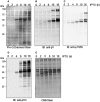Tyrosine Phosphorylation of the BRI1 Receptor Kinase Occurs via a Post-Translational Modification and is Activated by the Juxtamembrane Domain
- PMID: 22891071
- PMCID: PMC3413876
- DOI: 10.3389/fpls.2012.00175
Tyrosine Phosphorylation of the BRI1 Receptor Kinase Occurs via a Post-Translational Modification and is Activated by the Juxtamembrane Domain
Abstract
In metazoans, receptor kinases control many essential processes related to growth and development and response to the environment. The receptor kinases in plants and animals are structurally similar but evolutionarily distinct and thus while most animal receptor kinases are tyrosine kinases the plant receptor kinases are classified as serine/threonine kinases. One of the best studied plant receptor kinases is Brassinosteroid Insensitive 1 (BRI1), which functions in brassinosteroid signaling. Consistent with its classification, BRI1 was shown in early studies to autophosphorylate in vitro exclusively on serine and threonine residues and subsequently numerous specific phosphoserine and phosphothreonine sites were identified. However, several sites of tyrosine autophosphorylation have recently been identified establishing that BRI1 is a dual-specificity kinase. This raises the paradox that BRI1 contains phosphotyrosine but was only observed to autophosphorylate on serine and threonine sites. In the present study, we demonstrate that autophosphorylation on threonine and tyrosine (and presumably serine) residues is a post-translational modification, ruling out a co-translational mechanism that could explain the paradox. Moreover, we show that in general, autophosphorylation of the recombinant protein appears to be hierarchical and proceeds in the order: phosphoserine > phosphothreonine > phosphotyrosine. This may explain why tyrosine autophosphorylation was not observed in some studies. Finally, we also show that the juxtamembrane domain of BRI1 is an activator of the kinase domain, and that kinase specificity (serine/threonine versus tyrosine) can be affected by residues outside of the kinase domain. This may have implications for identification of signature motifs that distinguish serine/threonine kinases from dual-specificity kinases.
Keywords: autophosphorylation; brassinosteroid signaling; hierarchical phosphorylation; juxtamembrane domain; signal transduction.
Figures








References
LinkOut - more resources
Full Text Sources
Molecular Biology Databases

